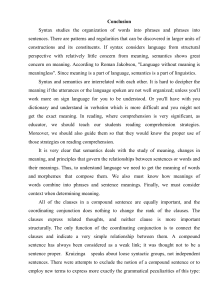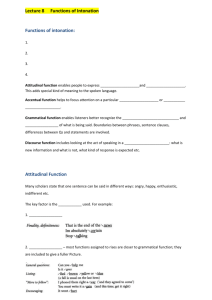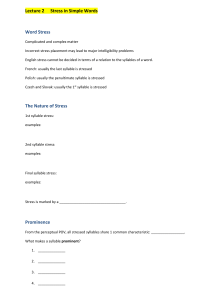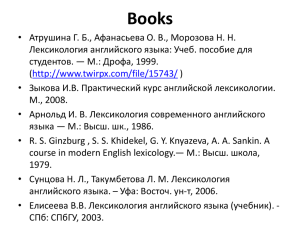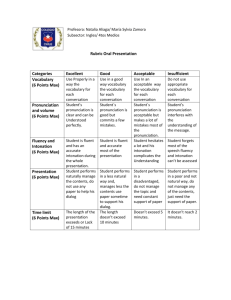программа
advertisement
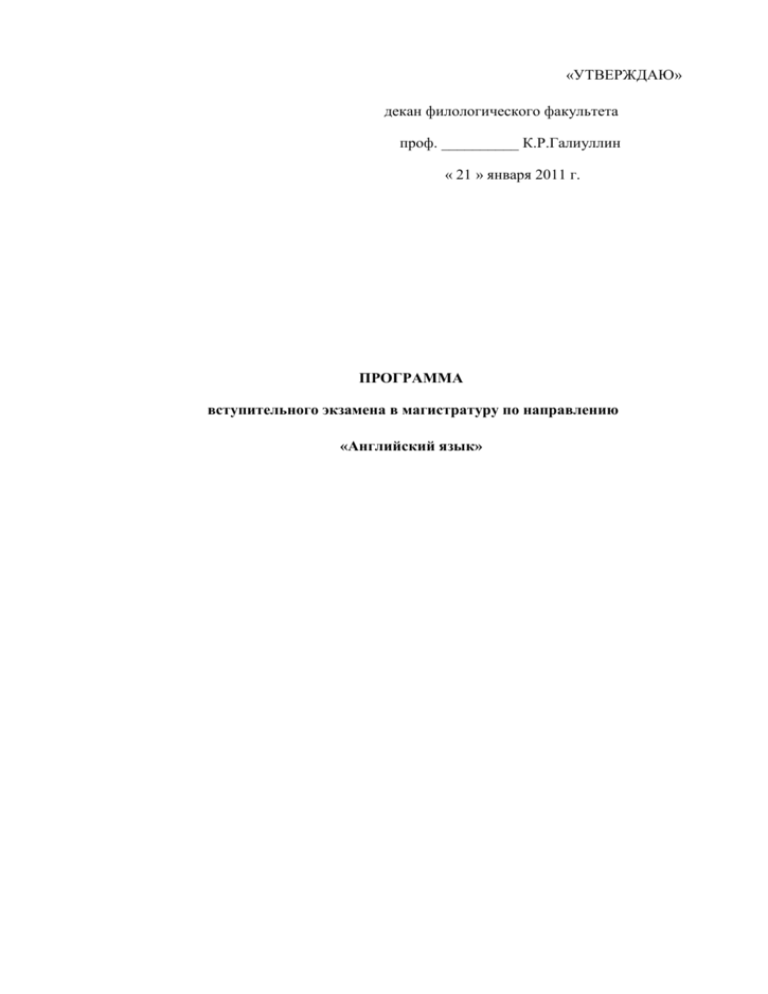
«УТВЕРЖДАЮ» декан филологического факультета проф. __________ К.Р.Галиуллин « 21 » января 2011 г. ПРОГРАММА вступительного экзамена в магистратуру по направлению «Английский язык» НАПРАВЛЕНИЕ «ФИЛОЛОГИЯ» МАГИСТЕРСКАЯ ПРОГРАММА «Английский язык» Программа вступительного испытания Theoretical phonetics Basic units of phonology The phoneme, the allophone. Distinctive features of phonemes. Complementary distribution. Free variation. The functions of the phoneme. Modifications of phonemes in speech: assimilation, accommodation, elision, reduction. Sound insertion. The syllable Theories of the nature of the syllable. Syllable formation. The rules of syllable division. Functions of the syllable. Word stress. The nature of English word stress: the recessive tendency, the tentative tendency, the rhythmic tendency. Functions of word stress. Intonation, its nature, components. Rhythm, tempo, pausation. Functions of intonation. Prosodic units: syllable, rhythmic group, intonation group, the utterance. The structure of the intonation group. Types of head, prehead, tail. Utterance stress. Standard English pronunciation and regional varieties of pronunciation. The Southern British type of English pronunciation, the Northern regional type of English pronunciation, the Scottish regional type of English pronunciation. The American variant of the English language: The Eastern type, the Southern type, the General American type. Bibliography Дваржецкая М.П. Пипипенко О.Ф. практикум по теоретической фонетике английского языка. – Киев, 1981. Леонтьева С.Ф. Теоретический курс английской фонетики. – М., 2002. Соколова М.А., Гинтовт К.П. Теоретическая фонетика английского языка. – М., 1996. Mutt O. Social and regional varieties of present-day English. – Tartu, 1977. Lexicology Lexicology. Syntagmatic and paradigmatic relations. Methods of lexicological research. Definition and aims of the course. Its connection with phonetics, Grammar, Stylistics. The lexical system if the language. Syntagmatic and paradigmatic relations. Methods of lexicological research. Synchronic and diachronic approach. The theory of the word. Word as a language unit, its definition. A word and a morpheme. A word and word-combination. Word-building Types of world-building and their productivity. Affixation. Suffixed and Prefixes. Allomorphs. International affixes. Composition. Principal criteria of compound words. Chief peculiarities of compound words. Classifications. Conversion. Different conceptions of conversion. Semantic relations between conversion pairs. Shortenings. Clippings. Abbreviations. Minor means of word-building. Sound-interchange. Stress-interchange. Sound-imitation. Reduction. Blends. Back-formation. Semasiology. Word meaning. Polysemy. Homonymy. Semasiology, its object and problems. Words meaning and its relations to the notion expressed by a word. The semantic structure of a word. Elements of the semantic structure. Lexicosemantic variants. Semantic changes of development of words. Causes of semantic change. Polysemy. Homonymy. Classification of homonyms. Etymological peculiarities of the English word-stock. Native words and borrowed words. The source of borrowings and the origin of borrowed words. Way of borrowings. Some formal indications of borrowed words of Greek, Latin, Scandinavian and French borrowings. Assimilation of borrowed words. Translation-loans. International words. The English language and its variants. Distribution of English. Local British dialects. Outlying dialects of British English. American English. Peculiarities of American English. The theory of “American language”. Bibliography Аракин В.Д. Англо-русский словарь. – М., 1997. Антрушина Г.Б. Афанасьева О.В. Морозова Н.Н. Лексикология английского языка. – М., 1999. Лингвистический энциклопедический словарь. – М., 1990. Смирницкий А.И. Русско-английский словарь. – М., 1998. Телия В.Н. Коннотативный аспект семантики номинативных единиц. – М., 1981. Bryson B. Mother Tongue. The English Language. – London, 1991. Crystal D. The English Language. – London, 1990. Manerko L. English Etymology Through the History of the British People. – Рязань, 1998. Morphology and Syntax The basic units of the morphological system of language The segmental units of morphology as part of the grammatical theory. The notion of morph. Types of morphs. The definition of morpheme. The notion of allomorph. Classification of morphemes. The complete morphemic model of the common English word. The definition of the word as a nominative unit of language formed by morphemes. Parts of speech. Various approaches to their classification. Noun as a part of speech. Theories of parts of speech classification. The principles of syntactico-distributional classification of English words. The three-criteria characterization of grammatical classes of words developed in home linguistics. Notional parts of speech. Functional parts of speech. The subdivision of parts of speech into subseries according to various particular semantico-functional and formal features of the constituent words. General characteristics of the noun as a part of speech: semantic, morphological, functional. Verb. The category of Tense. The problem of the future Tense. Description of the English verb: the categorical meaning of the verb, its morphological system, syntactic function. The category of tense in different linguistic theories. Absolute and relative tenses in M.Bloch’s teaching. The category of primary time. The category of prospective time (prospect). The interrelation of the two categories. The problem of future tense in foreign and home linguistics. The subject of syntax. Minor and major syntax. Principal differences between the phrase and the sentence. The subject-matter of syntax. The basic syntactic notions: the phrase, the sentence, the suprasegmental construction. Their definitions. The notions or minor and major syntax. The phrase and the sentence. Essential differences. The sentence. Its definition. Classification of sentences. Different approaches to the definition of the sentence. The sentence as part of language and speech. Classification of sentences according to the purpose of communication. Communicative types of sentences in traditional grammar. Ch.Fries’s classification of sentences. The problem of the exclamatory sentence. The property of exclamation as an accompanying feature effected within the system of the three cardinal sentence-types. Intermediary communicative types of sentences. Classification of sentences according to structure. Expanded and one-member (oneaxis) sentences. Sentence and the text. Sentence as the central structural-syntactic element of the language. The distinguishing features of the text as a lingual element. Monologue and dialogue texts. Types of sentence connection in monologue texts. Types of sentence connection in dialogue texts. The basic points of difference between a suprasegmental unity and a paragraph. The notion of sentence as the central structural-syntactic element of language. Bibliography Александрова О.В. Комова Т.А. Современный английский язык: Морфология и синтаксис. – М., 1998. Блох М.Я. Теоретическая грамматика английского языка. – М., 2000. Блох М.Я. Теоретические основы грамматики. – М., 2000. Гуревич В.В. Теоретическая грамматика английского языка: Сравнительная типология английского и русского языков. – М., 2003. Longman Grammar of Spoken and Written English / D. Biber, S. Johansson, G. Leech, S. Conrad, E. Finegan. - Frome, 2000.



